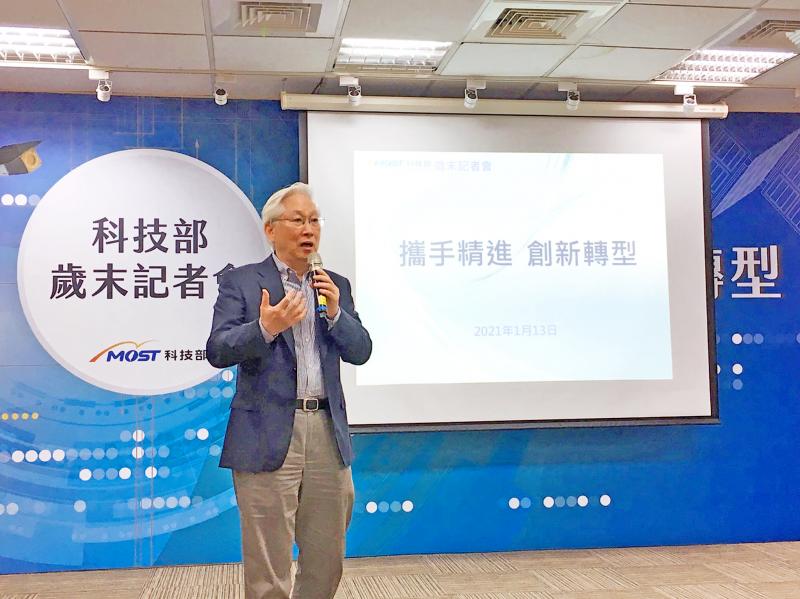Taiwan’s first low-orbit communications satellite would be launched by 2025, and the government has budgeted NT$4 billion (US$140.62 million) for its development, Minister of Science and Technology Wu Tsung-tsong (吳政忠) said yesterday.
The Beyond 5G communications satellite would be jointly developed by the Ministry of Science and Technology, and the Ministry of Economic Affairs, Wu told a news conference in Taipei.
The program seeks to help local companies make inroads into the emerging low-orbit satellite communications industry, led by US rocket supplier SpaceX’s Starlink program, he said.

Photo: Yang Mian-chieh, Taipei Times
Taiwan’s semiconductor, information and communications technology developers are competitive on the global stage and could pave the way for local firms to supply key components, modules and subsystems to communications satellites and related applications, Wu said.
The Beyond 5G’s launch might be conducted by a foreign entity, he added.
National Space Organization Director-General Lin Chun-liang (林俊良) said that his agency, which is part of the science ministry, would work with the economic ministry’s Industrial Technology Research Institute and Industrial Development Bureau on the program.
The institute would develop the satellite’s communications payload, while the space organization is in charge of the development of the satellite’s mechanical components and ground station control, Lin said.
After the satellite is launched, the government would encourage local firms to get involved in the development of six other communications satellites, he added.
The space organization is supporting three CubeSat programs developed by local researchers, Wu said.
The Ionospheric Dynamics Explorer and Attitude Subsystem Satellite, developed by National Central University, and the YuSat, developed by National Taiwan Ocean University and local firms, would be launched on SpaceX’s Falcon 9 rocket on Thursday next week, Wu said.
The NutSat, developed by National Formosa University, is scheduled to be launched in June, Wu said.
The three CubeSats have already been delivered to the US, Lin said.
In related news, the science ministry said it has submitted a space development draft bill for review to the Executive Yuan.
The science ministry is seeking to upgrade the space organization and outsource it from the National Applied Research Laboratories, which is also governed by the ministry, Wu said.

Taiwan is stepping up plans to create self-sufficient supply chains for combat drones and increase foreign orders from the US to counter China’s numerical superiority, a defense official said on Saturday. Commenting on condition of anonymity, the official said the nation’s armed forces are in agreement with US Admiral Samuel Paparo’s assessment that Taiwan’s military must be prepared to turn the nation’s waters into a “hellscape” for the Chinese People’s Liberation Army (PLA). Paparo, the commander of the US Indo-Pacific Command, reiterated the concept during a Congressional hearing in Washington on Wednesday. He first coined the term in a security conference last

Prosecutors today declined to say who was questioned regarding alleged forgery on petitions to recall Democratic Progressive Party (DPP) legislators, after Chinese-language media earlier reported that members of the Chinese Nationalist Party (KMT) Youth League were brought in for questioning. The Ministry of Justice Investigation Bureau confirmed that two people had been questioned, but did not disclose any further information about the ongoing investigation. KMT Youth League members Lee Hsiao-liang (李孝亮) and Liu Szu-yin (劉思吟) — who are leading the effort to recall DPP caucus chief executive Rosalia Wu (吳思瑤) and Legislator Wu Pei-yi (吳沛憶) — both posted on Facebook saying: “I

The Ministry of Economic Affairs has fined Taobao NT$1.2 million (US$36,912) for advertisements that exceed its approved business scope, requiring the Chinese e-commerce platform to make corrections in the first half of this year or its license may be revoked. Lawmakers have called for stricter enforcement of Chinese e-commerce platforms and measures to prevent China from laundering its goods through Taiwan in response to US President Donald Trump’s heavy tariffs on China. The Legislative Yuan’s Finance Committee met today to discuss policies to prevent China from dumping goods in Taiwan, inviting government agencies to report. Democratic Progressive Party Legislator Kuo Kuo-wen (郭國文) said

Sung Chien-liang (宋建樑), who led efforts to recall Democratic Progressive Party (DPP) Legislator Lee Kun-cheng (李坤城), was released on bail of NT$80,000 today amid outcry over his decision to wear a Nazi armband to questioning the night before. Sung arrived at the New Taipei District Prosecutors’ Office for questioning in a recall petition forgery case last night wearing a red armband bearing a swastika, carrying a copy of Adolf Hitler’s Mein Kampf and giving a Nazi salute. Sung left the building at 1:15am without the armband and covering the book with his coat. Lee said today that this is a serious